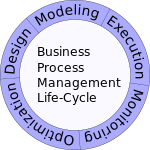
Business process management (BPM) has been referred to as a "holistic management" approach to aligning an organization's business processes with the wants and needs of clients. It promotes business effectiveness and efficiency while striving for innovation, flexibility, and integration with technology. BPM attempts to improve processes continuously. It can therefore be described as a "process optimization process." It is argued that BPM enables organizations to be more efficient, more effective and more capable of change than a functionally focused, traditional hierarchical management approach. These processes are critical to any organization,[citation needed] as they can generate revenue and often represent a significant proportion of costs. As a managerial approach, BPM sees processes as strategic assets of an organization that must be understood, managed, and improved to deliver value-added products and services to clients. This foundation closely resembles other Total Quality Management or Continuous Improvement Process methodologies or approaches. BPM goes a step further by stating that this approach can be supported, or enabled, through technology to ensure the viability of the managerial approach in times of stress and change. In fact, BPM offers an approach to integrate an organizational "change capability" that is both human and technological. As such, many BPM articles and pundits often discuss BPM from one of two viewpoints: people and/or technology.
Source : wikipedia
----------
BPM life-cycle
Business process management activities can be grouped into six categories: vision, design, modeling, execution, monitoring, and optimization.Functions are designed around the strategic vision and goals of an organization. Each function is attached with a list of processes. Each functional head in an organization is responsible for certain sets of processes made up of tasks which are to be executed and reported as planned. Multiple processes are aggregated to function accomplishments and multiple functions are aggregated to achieve organizational goals.
Design
Process Design encompasses both the identification of existing processes and the design of "to-be" processes. Areas of focus include representation of the process flow, the factors within it, alerts & notifications, escalations, Standard Operating Procedures, Service Level Agreements, and task hand-over mechanisms.Good design reduces the number of problems over the lifetime of the process. Whether or not existing processes are considered, the aim of this step is to ensure that a correct and efficient theoretical design is prepared.
The proposed improvement could be in human-to-human, human-to-system, and system-to-system workflows, and might target regulatory, market, or competitive challenges faced by the businesses.
The existing process and the design of new process for various application will have to synchronise as such will not effect the business in major outage. The business as usual is the standard to be attained when design of process for multiple systems is considered.
Modeling
Modeling takes the theoretical design and introduces combinations of variables (e.g., changes in rent or materials costs, which determine how the process might operate under different circumstances).It also involves running "what-if analysis" on the processes: "What if I have 75% of resources to do the same task?" "What if I want to do the same job for 80% of the current cost?".
Execution
One of the ways to automate processes is to develop or purchase an application that executes the required steps of the process; however, in practice, these applications rarely execute all the steps of the process accurately or completely. Another approach is to use a combination of software and human intervention; however this approach is more complex, making the documentation process difficult.As a response to these problems, software has been developed that enables the full business process (as developed in the process design activity) to be defined in a computer language which can be directly executed by the computer. The system will either use services in connected applications to perform business operations (e.g. calculating a repayment plan for a loan) or, when a step is too complex to automate, will ask for human input. Compared to either of the previous approaches, directly executing a process definition can be more straightforward and therefore easier to improve. However, automating a process definition requires flexible and comprehensive infrastructure, which typically rules out implementing these systems in a legacy IT environment.
Business rules have been used by systems to provide definitions for governing behaviour, and a business rule engine can be used to drive process execution and resolution.
Monitoring
Monitoring encompasses the tracking of individual processes, so that information on their state can be easily seen, and statistics on the performance of one or more processes can be provided. An example of the tracking is being able to determine the state of a customer order (e.g. order arrived, awaiting delivery, invoice paid) so that problems in its operation can be identified and corrected.In addition, this information can be used to work with customers and suppliers to improve their connected processes. Examples of the statistics are the generation of measures on how quickly a customer order is processed or how many orders were processed in the last month. These measures tend to fit into three categories: cycle time, defect rate and productivity.
The degree of monitoring depends on what information the business wants to evaluate and analyze and how business wants it to be monitored, in real-time, near real-time or ad-hoc. Here, business activity monitoring (BAM) extends and expands the monitoring tools generally provided by BPMS.
Process mining is a collection of methods and tools related to process monitoring. The aim of process mining is to analyze event logs extracted through process monitoring and to compare them with an a priori process model. Process mining allows process analysts to detect discrepancies between the actual process execution and the a priori model as well as to analyze bottlenecks.

Thanks for sharing the post. Good information about BPM is given which helps us to know about what BPM stands for and its objectives like how it helps organizations in improving customer experience, simplifying business processes, increasing productivity etc.
ReplyDelete